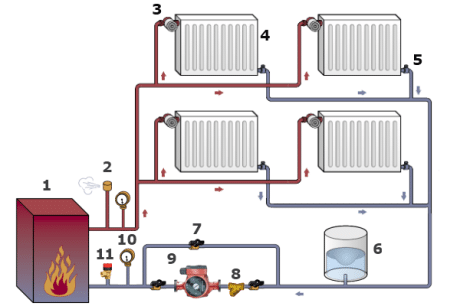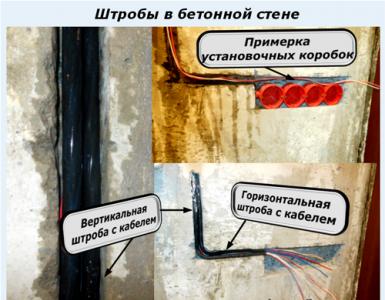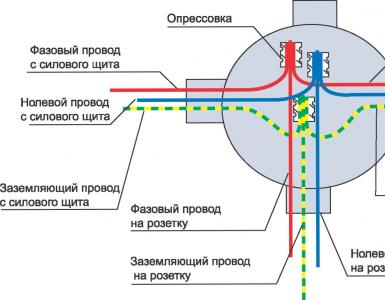Connecting a heating radiator: types and methods of piping the heating system
When arranging heating, not only the design and type of radiators, but also the type of wiring are of fundamental importance. It is chosen depending on the characteristics of the circulation of the coolant, operational requirements, and the layout of the room. In many ways, connecting a heating radiator determines the functionality and performance of the entire system as a whole. There are several schemes - lower, side, diagonal. The latter is considered the most rational, because with this connection, heat is distributed more evenly, but it is not always possible, so it makes sense to consider all options and choose the best one.
Types of heating systems
Distinguish one- and two-pipe systems. The principle of operation of a single-pipe is to connect heating radiators in series. The coolant passes through them in turn, giving off heat, and returns to the heat generator already cooled down. After that, it heats up again, and the whole cycle repeats. Water is usually used as a coolant, less often antifreeze. Two-pipe heating involves parallel connection of batteries.
Connecting batteries in a two-pipe system
Advantages and disadvantages of single-pipe heating
In a single-pipe system, the circulation of the coolant is natural; when designing, it is necessary to calculate the slope angle. You can also install a circulation pump. For greater efficiency, the system can be supplemented with temperature controllers, taps, valves, valves. This allows you to control the heating temperature of individual heaters.
The greatest advantage of single-pipe heating is the minimum cost of materials. The system can be vertical and horizontal. The first is used in the arrangement of heating of apartment buildings, and the second is advisable to design for spacious rooms, incl. production, warehouse, trade.
The disadvantage of single-pipe circuits is the need to use batteries with different heat transfer rates in order to achieve the same heating of the premises. The first radiator should be the smallest, the subsequent ones should be large. Otherwise, the building will be heated unevenly: some rooms are larger, others smaller. To be able to disconnect the batteries without completely shutting down the entire system, bypasses are installed.

Scheme of a single-pipe heating system
Features of the two-pipe system
A two-pipe connection provides for the presence of a riser through which the coolant rises, and two pipes - supply and return. Circulation can be natural or forced (using a pump). All batteries in such a system heat up evenly, heat loss is minimal. But the cost of a two-pipe connection is significantly higher than a single-pipe connection, because twice as much materials are required. The system must be equipped with air bleed valves.
Note! For the installation of radiators in single-pipe heating, one-sided wiring is most often used, and a two-pipe system is universal.

Two-pipe heating scheme
Connection options for heating radiators
Methods for connecting batteries depend on the type of system and the circulation of the coolant (forced or natural). There are such types:
- saddle and bottom connection of heating radiators;
- unilateral (lateral);
- diagonal (cross).
Scheme of one-way connection of heating devices
This scheme is convenient for apartment buildings with small rooms. It works most effectively if the number of battery sections does not exceed 12-15. The more sections, the worse the section of the device that is located at the greatest distance from the supply pipe warms up. Heat transfer is reduced. Lateral connection of heating radiators is considered the cheapest of all, therefore it was very popular in the Soviet period.
The temperature of the coolant can be controlled using special jumpers. They are installed so that part of the heated liquid passes from one battery to the next, maintaining the temperature. It is highly undesirable to arbitrarily dismantle such a jumper in an apartment building with centralized heating.
Diagonal connection of radiators
The best way to connect heating radiators is considered diagonal. It is also called cross. With such a wiring, the coolant moves from different sides from top to bottom. As a result, the heater evenly warms up, heat loss is minimal. The cross scheme is used in two-pipe systems, since the temperature of the coolant constantly decreases when passing through the batteries. The supply of heated water is carried out through the upper branch pipe, and the outlet is connected to the lower one.
What does the bottom connection look like?
Experts recommend designing this type of wiring if it is impossible to equip others. It is convenient if the pipes are laid near the floor or under it. Both pipes - supply and discharge - are located below. Heating devices connected according to this scheme work 12-15% less efficiently than they should. Their upper part warms up weakly and unevenly. If there is a need for arranging a lower connection, then it is better to choose aluminum or bimetallic heaters in order to increase heat transfer.

The appearance of a heating radiator with a lower wiring
So what kind of connection of heating radiators is better? The one that corresponds to the type of heating system, layout and operating conditions of a particular room. Experts consider the diagonal wiring scheme to be the most effective, but it is not always possible to equip it. There are no recipes here. If you have any doubts about this issue, be sure to consult with professionals and take into account their opinion.













